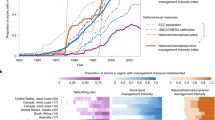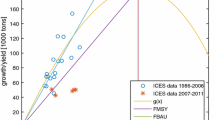Abstract
We studied the optimal age- and season-specific sustainable harvesting policy for a fish population. We assumed that body weight, reproduction rate, and natural mortality of a fish vary with age. By assuming completely age- and season-specific harvesting, we can obtain a new, simple criterion for fishing policy. Fishers should catch a fish of a particular age if, and only if, the current value at that age is larger than the harvest value plus the impact multiplier times the reproductive value. Here the harvest value is the expected yield per individual in the future, the impact multiplier is a shadow price for a laid egg and is constant irrespective of the age of the mother fish, and the reproductive value is the expected number of eggs spawned by a fish after that age.
Similar content being viewed by others
References
Beddington JR, Taylor DB (1973) Optimum age specific harvesting of a population. Biometrics 29:801–809
Clark CW (1990) Bioeconomic modelling and fisheries management, 2nd edn. Wiley-Interscience, New York, pp 1–384
Fisher RA (1930) The genetical theory of natural selection. Clarendon Press, Oxford (reprinted 1958, Dover, New York), pp 1–272
Getz WM, Haight RG (1989) Population harvesting, demographic models of fish, forest, and animal resources. In: Monographs in population biology. Princeton University Press, Princeton, NJ, pp 1–391
Hamilton WD (1966) The moulding of senescence by natural selection. Journal of Theoretical Biology 12:12–45
Iwasa Y, Roughgarden J (1984) Shoot/root balance of plants, optimal growth of a system with many vegetative organs. Theoretical Population Biology 25:78–105
Kotaki K (1991) Report on the technological development test of long-term forecasting on fisheries and oceanographic conditions (Heisei 2 fiscal year) (in Japanese). Japan Fisheries Information Service Center, Tokyo, pp 81–100
Mace PM (1994) Relationships between common biological reference points used as thresholds and targets of fisheries management strategies. Canadian Journal of Fisheries and Aquatic Sciences 51:110–122
Matsuda H, Wada T, Takeuchi Y, Matsumiya Y (1991) Alternative models for species replacement of pelagic fishes. Researches on Population Ecology 33:41–56
Matsuda H, Kishida T, Kidachi T (1992a) Optimal harvesting policy for chub mackerel in Japan under a fluctuating environment. Canadian Journal of Fisheries and Aquatic Sciences 49:1796–1800
Matsuda H, Wada T, Takeuchi Y, Matsumiya Y (1992b) Model analysis of the effect of environmental fluctuation on the species replacement pattern of pelagic fishes under interspecific competition. Researches on Population Ecology 34:309–319
Matsuda H, Mitani I, Asano K (1994) Impact factors of purse seine net and dip net fisheries on a chub mackerel population. Researches on Population Ecology 36:201–207
Matsuda H, Fukase K, Kotaki K, Asano K (1996) Inconsistency between the per capita fecundity and estimation of the yearly egg production of the chub mackerel (Scomber japonicus) in Japan. Fisheries Science 62:178–183
Myers RA, Mertz G (1998) The limits of exploitation: a precautionary approach. Ecological Applications 8:165–169
Reed WJ (1979) Optimal escapement levels in stochastic and deterministic harvesting models. Journal of Environmental Economical Management 6:350–363
Reed WJ (1980) Optimum age-specific harvesting in a nonlinear population model. Biometrics 36:579–593
Yamauchi A, Matsumiya Y, Iwasa Y (1997) Optimal age-dependent sustainable harvesting of natural resource populations: sustainability value. Researches on Population Ecology 39:139–148
Author information
Authors and Affiliations
About this article
Cite this article
Matsuda, H., Yamauchi, A., Matsumiya, Y. et al. Reproductive value, harvest value, and impact multiplier as indicators for maximum sustainable fisheries. Environ Econ Policy Stud 2, 129–146 (1999). https://doi.org/10.1007/BF03353907
Received:
Accepted:
Published:
Issue Date:
DOI: https://doi.org/10.1007/BF03353907




